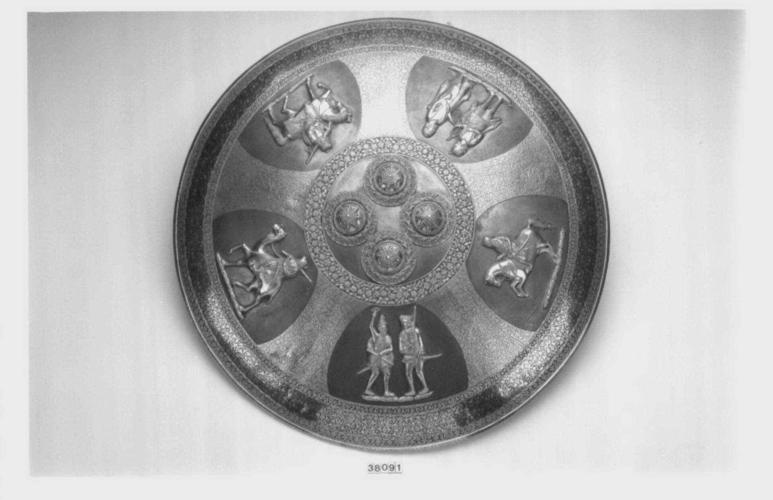-
1 of 253523 objects
Shield 1865
Watered crucible steel, gold, silver, velvet | 10.0 x 68.8 x 69.0 cm (whole object) | RCIN 38091
-
A convex, circular, watered crucible steel shield or dhal decorated with numerous bands of gold foliage, variously inlaid and engraved, framing applied steel figures overlaid in gold, with four applied bosses in the centre. This style of gold decoration is known as kuftkari and involves crosshatching the steel and applying gold wire to create the desired pattern. This technique was used extensively by craftsman based in Sialkot and Gujrat to decorate arms and armour. Following the annexation of Punjab by the British East India Company in 1849, many of the craftsmen practising this technique began to work commercially and decorated objects for presentation such as address caskets and this presentational shield. The figures in the reserves include Sikh armed fighters known as Akalis or Nihangs, recognisable by their tall conical turban or bunga dastar.The gifts were illustrated in the Illustrated London News (6 May 1865) and records the shield as 'of very handsome workmanship, with four large diamond bosses in the centre, given by the European and native inhabitants of the Punjuab [sic]. it was considered that a shield would be a fitting emblem of the Punjuab, as the Punjuab is a frontier province and its army holds the gates of India'. The 'large diamond bosses' appear to have been repurposed after entering the collection.
Provenance
Presented to King Edward VII and Queen Alexandra when Prince and Princess of Wales on the occassion of their marriage by the subjects and residents of Punjab in 1865
-
Medium and techniques
Watered crucible steel, gold, silver, velvet
Measurements
10.0 x 68.8 x 69.0 cm (whole object)
Category
Object type(s)
Place of Production
Punjab [India]
